花旗银行介绍PPT
- 格式:ppt
- 大小:16.29 MB
- 文档页数:19

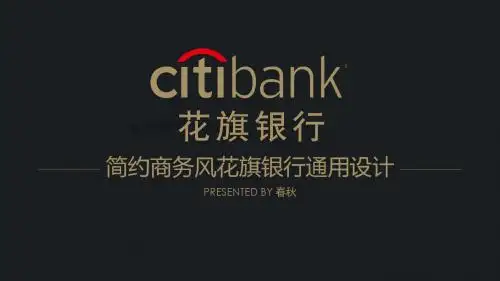

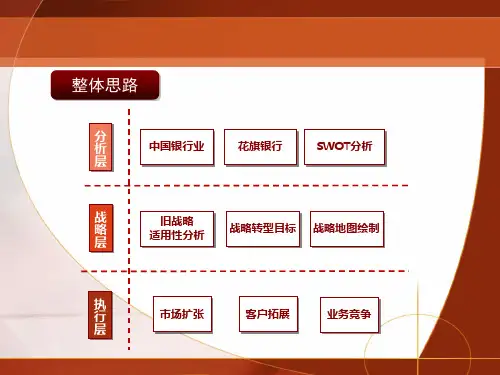
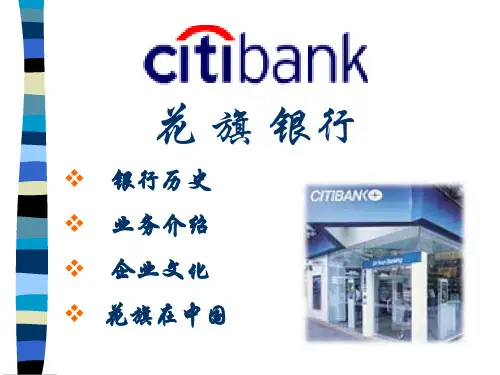
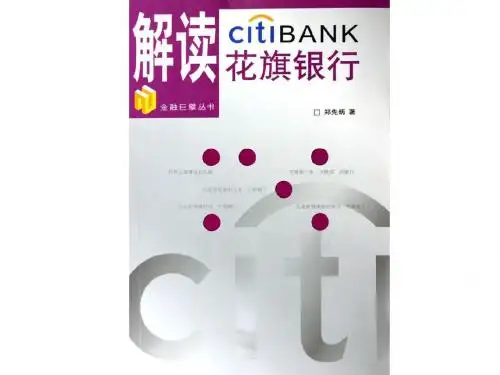

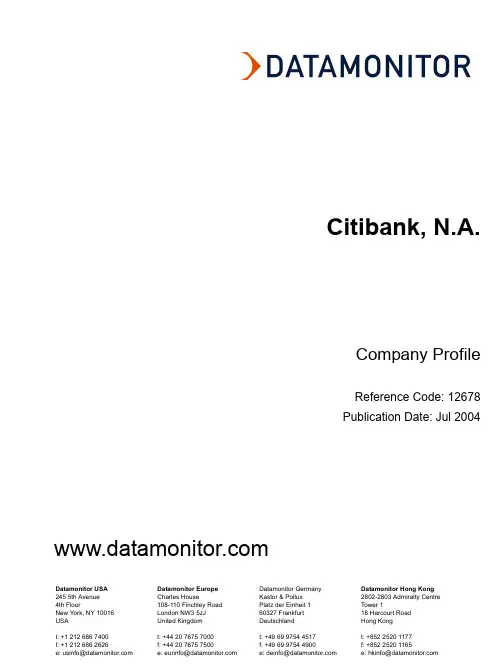
Datamonitor USA 245 5th Avenue4th Floor Datamonitor EuropeCharles House108-110 Finchley RoadDatamonitor GermanyKastor & PolluxPlatz der Einheit 1Datamonitor Hong Kong2802-2803 Admiralty CentreTower 1Citibank, N.A.Company ProfileReference Code: 12678Publication Date: Jul 2004ABOUT DATAMONITORDatamonitor is a leading business information company specializing in industryanalysis.Through its proprietary databases and wealth of expertise, Datamonitor providesclients with unbiased expert analysis and in depth forecasts for six industry sectors:Healthcare, Technology, Automotive, Energy, Consumer Markets, and FinancialServices.The company also advises clients on the impact that new technology and eCommercewill have on their businesses. Datamonitor maintains its headquarters in London, andregional offices in New York, Frankfurt, and Hong Kong. The company serves theworld's largest 5000 companies.Datamonitor's premium reports are based on primary research with industry panelsand consumers. We gather information on market segmentation, market growth andpricing, competitors and products. Our experts then interpret this data to producedetailed forecasts and actionable recommendations, helping you create new businessopportunities and ideas.Our series of company, industry and country profiles complements our premiumproducts, providing top-level information on 10,000 companies, 2,500 industries and50 countries. While they do not contain the highly detailed breakdowns found inpremium reports, profiles give you the most important qualitative and quantitativesummary information you need - including predictions and forecasts.All Rights Reserved.No part of this publication may be reproduced, stored in a retrieval system or transmitted in any form by any means, electronic, mechanical, photocopying, recording or otherwise, without the prior permission of the publisher, Datamonitor plc.The facts of this profile are believed to be correct at the time of publication but cannot be guaranteed. Please note that the findings, conclusions and recommendations that Datamonitor delivers will be based on information gathered in good faith from both primary and secondary sources, whose accuracy we are not always in a position to guarantee. As such Datamonitor can accept no liability whatever for actions taken based on any information that may subsequently prove to be incorrect.TABLE OF CONTENTSCompany Overview (4)Key Facts (4)Business Description (5)History (6)Key Employees (8)Major Products And Services (10)Products And Services Analysis (11)SWOT Analysis (15)Top Competitors (20)Locations and Subsidiaries (21)Company OverviewCOMPANY OVERVIEWCitibank is the consumer and corporate banking division of leading financial servicescompany Citigroup. The company has operations in around 1,700 locations, in morethan 40 countries worldwide. Citibank offers such banking staples as basic bankingaccounts and investment services, through such brands as Citicorp InvestmentServices, CitiTerm life insurance and CitiPhone banking. The firm also cross-sellsproducts form its parent company, and other subsidiaries of Citigroup. Citibank isheadquartered in New York.Citibank has no published revenues for 2003. The company’s revenues are detailedwithin the Citigroup (Parent company) published accounts for 2003.KEY FACTSHead Office Citibank, N.A.399 Park AvenueNew YorkNY 10022United StatesPhone+1 212 559 1000Fax+1 212 793 3946Web Address Revenues/turnover45883(US$ Mn)Financial Year End DecemberEmployees129545SIC Codes SIC 6011 Federal Reserve BanksSIC 6019 Central Reserve Depository Institutions, NECSIC 6021 National Commercial BanksSIC 6712 Offices of Bank Holding CompaniesNAICS Codes52111, 522298, 52211, 52221, 551111Business DescriptionBUSINESS DESCRIPTIONCitibank delivers a wide array of banking, lending and investment services toindividual consumers, small businesses, large corporations and governments, as wellas institutional and individual investors.The company divides its operations into three sectors: personal finance, smallbusiness and corporate/institutional. There is some overlap in the products betweenthe divisions. For example, products such as credit cards and insurance are offered inmore than one sector, but this is all part of Citibank’s policy to offer solutions to caterfor any financial situation.Citibank’s financial center network is comprised of local offices and complemented bythe group’s electronic delivery systems, including ATMs and the World Wide Web.Specific products and services include basic banking accounts and investmentservices offered through Citicorp Investment Services, CitiTerm life insurance,CitiPhone banking, and CitiGold accounts, which integrate banking, borrowing, andinvestment services. Among the many credit card solutions for individuals andbusinesses are the Citi Smart Card, Citi Advantage Card, Citi Platinum Select Card,and Citi Platinum Select Advantage Business Card.Citibank also operates an Internet banking site offering consumer and small businessproducts and services. At , consumers may sign onto their Citi card,bank and brokerage accounts, locate Citibank Financial Centers and ATMs globally,access personal finance content and use a wide variety of financial tools, among otherfunctions.As well as operating within its domestic market, the company has extensiveoperations in Asia, covering China, Hong Kong, India, Japan, the Philippines andSingapore. It also has offices in Europe, Latin America, the Middle East and Africa.Citibank focuses substantial resources on growth in emerging markets. The companyoffers two transaction banking businesses for these areas - eBusiness, eCommerce,cash-management and electronic-banking business; and Citibank global securitiesservices, which provides securities-related services such as custody, clearing, agencyand trust, and depositary receipts. In addition, its sales and trading business providescapital markets products to clients.HISTORYCitibank was founded in 1812 as the City Bank of New York. City Bank joined the newUS national banking system in 1865 and became The National City Bank of New York.By 1894, the company had become the largest bank in the US.The company began its international operations in 1902 with the opening of offices inAsia, including Shanghai and Manila. Meanwhile in 1914, National City inauguratedthe first foreign branch of any US national bank, in Buenos Aires. An office in Rio deJaneiro opened in 1915.Citibank expanded its operations in 1918 with the acquisition of International BankingCorporation, a US overseas bank. By 1929, the bank had become the largestcommercial bank in the world. Expansion was accelerated that year with a merger: theFarmers’ Loan and Trust Company became the City Bank Farmers Trust Company.Meanwhile, in 1955, the bank changed its name to The First National City Bank ofNew York. 1961 saw First National City Overseas Investment Corporation become thebank’s holding company for non-US-based subsidiaries and affiliates. The bankmarked its 150th anniversary in 1962 by shortening its name to First National CityBank.In the 1970s, the company changed its name again. First National City Bank becameCitibank, N.A. (for National Association) in 1976, while the First National CityCorporation holding company changed its name to Citicorp to better suit its globalbusinesses.The company further expanded its businesses in 1981 with the purchase of DinersClub. By 1992, Citibank, N.A. had become the largest bank in the US. Meanwhile, in1993, the company merged the savings banks it acquired in the 1980s and beganoperating them as Citibank, FSB under a single charter.International expansion in the 1990s included the opening of the first fully foreignowned commercial bank in Russia (1994), and the first full service branch in China(1995). It also opened branches in Vietnam and South Africa.Citibank was merged into Citigroup in 1998 after all Citicorp and Travelers Groupdivisions merged to become Citigroup Inc.1999 saw Citibank enhance international growth with the purchase of FinancieroAtlas, the second largest consumer finance company in Chile. The following year sawthe company become the first international bank to open a full-service branch in Israel. Further international purchases that year included the Hungarian retail activities of ING Bank.In 2001, Citibank and China Merchants Bank issued China’s first international travel cash card, Visa Travel Money. Moreover, in 2002 Citibank announced it was to open retail-banking operations in Moscow, making it the first US bank to launch commercial operations in the country.In April 2002, Citibank announced a cooperation agreement with Galaxy Securities, China’s leading brokerage. The pact entailed Citibank providing advice to Galaxy, sharing expertise on securities and banking issues, as Galaxy prepared for the influx of competition spawned from China’s entry into the World Trade Organization. In return, Citibank waited for the relaxation of Chinese laws before it made a significant impact in the marketplace.In early November 2002, Citibank’s parent Citigroup announced the completion of the acquisition of Golden State Bancorp for $2.3 billion. Golden State was subsequently merged into Citibank. This move succeeded in expanding Citibank’s branch network in California fourfold.In January 2003, Citibank’s interest in the Chinese banking sector was furthered when it emerged that it was to purchase a minority stake in China-based Shanghai Pudong Development Bank.In December 2003, was ranked number one in online banking in the recent 2003 fourth quarter scorecard by Gómez, the Internet benchmarking and improvement strategies firm.Citibank, in February 2004, launched Citibanking, a new proposition aimed to providing more comprehensive banking services and sophisticated tools to meet the financial needs of the middle-income group in Hong Kong. The company also launched Citibanking in Malaysia in March 2004.In May 2004 Citibank and Cathay Pacific Airways launched the first co-brand credit card for frequent travelers.In June 2004 opened its first dedicated CitiGold Wealth Management Center. The new center was opened to meet growing demand fro wealth management services in Shanghai.KEY EMPLOYEESName Job Title Board Compensation Robert B. Willumstad President, CEO and Director Executive BoardWilliam R. Rhodes Chairman Non Executive BoardAlan S. MacDonald Vice Chairman Non Executive BoardTodd S. Thomson Director Non Executive BoardSir Deryck Maughan Director Non Executive BoardThomas W. Jones Director Non Executive BoardMarjorie Magner Director Non Executive BoardAnne MacDonald Head of Marketing Senior ManagementKEY EMPLOYEE BIOGRAPHIESRobert B. WillumstadBoard: Executive BoardJob Title: President, CEO and DirectorBob Willumstad is the president and COO of Citigroup. He is a member of theCitigroup management and business heads committee. Mr. Willumstad is on theboard of directors of Citigroup and is CEO and president of Citibank NA and serves onits board of directors.Alan S. MacDonaldBoard: Non Executive BoardJob Title: Vice ChairmanAlan S. MacDonald is the vice chairman of Citibank and Citicorp. He is also a memberof Citigroup’s corporate and investment bank operating committee, Internet operatingcommittee and Citigroup management committee.MAJOR PRODUCTS AND SERVICESCitibank is the consumer and corporate banking division of leading financial servicescompany Citigroup. The company has operations in around 1,700 locations, in morethan 40 countries worldwide. Citibank offers the following products and services:- Banking services- Credit cards- Mortgages- Loans- Investments- Planning/Retirement solutions- Insurance- Small business services- Corporate/Institutional services:- Asset management- Government services- Business Insurance- Private bankingPRODUCTS AND SERVICES ANALYSISThe following analysis is of the finances of Citigroup, Citibank’s parent, for the full year2003:In 2003, Citigroup’s revenues increased 9% on 2002, reaching $77.4 billion,outpacing expense growth of 5%. The majority of this growth was organic, largely as aresult of continued momentum with clients in an improved market environment. Netincome from continuing operations of $17.85 billion was up 33% from the prior year.In 2003 the company segmented its operations into five main groups; Globalconsumer group; Global Corporate & Investment group; Global InvestmentManagement; Private Client Services and Proprietary Investment Activities.Global Consumer groupThe Global Consumer group generated revenues of $41,195 million in 2003, up 8.5%on the previous year accounting for 53.2% of total revenues. Global Consumerreported net income of $9.648 billion in 2003, up $1.396 billion or 17% from 2002,driven by double-digit growth in Retail Banking and Cards, that was partially offset bya decline in Consumer Finance. Retail Banking net income increased $1.145 billion or38% in 2003 primarily due to the impact of the Golden State Bancorp (GSB)acquisition and strong international growth including improvement in Argentina.Cards net income increased $550 million or 18% in 2003 mainly reflecting the additionof the Sears and Home Depot portfolios, growth in Citi Cards and Asia, and lowercredit losses in Latin America. Consumer Finance net income decreased $271 millionor 12% in 2003 primarily due to continued weakness in Japan, partially offset bygrowth in North America, including the acquisition of GSB, and in EMEA. The Globalconsumer group accounted for 55% of total net income in 2003.Consumer Finance reported net income of $1.928 billion in 2003, down $271 millionor 12% from 2002, principally reflecting a decline in International Consumer Financeresulting from continued weakness in Japan. Thee decline was partially offset by theacquisition of GSB in November of 2002 and a $94 million release of a tax reserverelated to a settlement with tax authorities, which increased income in Japan.Net income of $2.199 billion in 2002 grew $294 million or 15% from 2001, primarilyreflecting revenue growth and continued efficiencies resulting from the integration ofAssociates in North America, partially offset by higher net credit losses in the US andJapan. The consumer finance segment accounted for 19.8% of total Consumer group income and 24.3% of Consumer group revenue.Revenues, net of interest expense, of $10.003 billion in 2003 increased $196 million or 2% from 2002. The increase in revenue reflected growth of $490 million or 8% in North America, partially offset by a decline of $294 million or 8% in International Consumer Finance. Revenue growth in North America was primarily driven by growth in receivables, which included the addition of the GSB auto portfolio, partially offset by declines in insurance-related revenue.Global Corporate & Investment Banking groupThe Global Corporate & Investment Banking group generated revenues of $20,040 million in 2003 accounting for 25.9% of total revenues. The group reported net income of $5.387 billion, $3.159 billion, and $4.392 billion in 2003, 2002, and 2001, respectively. The increase in 2003 net income reflects increases of $1.379 billion in Other Corporate, primarily reflecting the absence of a $1.3 billion after-tax charge in 2002 related to the establishment of reserves for regulatory settlements and related civil litigation, $637 million or 16% in Capital Markets and Banking, and $212 million or 38% in Transaction Services. This segment accounted for 31% of total income in 2003.Private Client servicesPrivate Client Services reported net income of $778 million in 2003 compared to $799 million in 2002 and total revenues of $5,827 million accounting for 7.5% of total revenues. Private Client Services net income decreased $21 million or 3% during 2003, primarily due to a higher effective tax rate and increased legal, advertising and marketing costs. This segment accounted for 4% of total income in 2003.Global Investment ManagementThe Global Investment management segment generated revenues of $8,688 million in 2003 accounting for 11.2% of total revenues. Global Investment Management reported net income of $1.696 billion in 2003, which was up $173 million or 11% from 2002. Life Insurance and Annuities net income of $751 million in 2003 increased $134 million compared to 2002, reflecting a $219 million or 39% increase in Travelers Life and Annuity (TLA) to $781 million, partially offset by a decrease of $85 million in International Insurance Manufacturing (IIM).The increase in TLA’s income was primarily driven by higher net realized insurance investment portfolio gains of $236 million, higher business volumes, and lower taxes, partially offset by higher deferred acquisition cost (DAC) amortization and reduced investment yields. The IIM net loss of $30 million in 2003 represented a decrease in income of $85 million from 2002, driven by impairments of Argentina Government Promissory Notes (GPNs) of $114 million and the impact of certain liability restructuring actions taken in the Argentina voluntary annuity business of $20 million, partially offset by increases in Asia of $24 million and Mexico of $20 million.Private Bank net income of $551 million in 2003 was up $88 million or 19% from 2002, primarily reflecting increased investment management and capital markets activity, lending activity, and a lower provision for credit losses, partially offset by higher expenses, reflecting incentive compensation expense associated with higher revenues and higher other employee-related costs, and the impact of narrowing interest rate spreads. Asset Management net income of $394 million in 2003 was down $49 million or 11% from 2002, primarily reflecting the impact of impairments in Argentina and reduced fee revenues, partially offset by the cumulative impact of positive net flows and lower expenses. Global Investment management accounted for 10% of total income in 2003.Proprietary Investment activitiesProprietary Investment Activities reported revenues, net of interest expense, of $1.008 billion in 2003, increased $1.043 billion from 2002 reflecting higher Private Equity results of $1.420 billion, primarily from higher net mark-to-market gains on public securities, higher net impairment/ valuation revenues, higher fee revenues and lower funding costs, partially offset by lower Other Investment Activities revenues of $377 million. The decline in Other Investment Activities was driven by the absence of the 2002 gain on the sale of 399 Park Avenue of $527 million, partially offset by higher fee revenues in CAI and dividends from TPC shares. This segment accounted for 1.3% of total revenues in 2003.Corporate/OtherCorporate/Other reported revenues, net of interest expense, of $687 million in 2003, which decreased $98 million from 2002, were primarily due to lower intersegment eliminations, partially offset by higher net treasury results. The treasury increase resulted from a gain on the sale of a convertible bond and favorable interest rate positioning, partially offset by lower realized gains on fixed income investments. This segment accounted for the remaining 0.9% of total revenues.Geographical breakdownThe US represents the biggest market of Citigroup accounting for 64% of total net income in 2003. Asia accounted for 10%; Japan 4%; Mexico 8%; EMEA 10% andLatin America 4%.SWOT ANALYSISCitibank is the consumer and corporate banking subsidiary owned by Citigroup. The company has operations in over 100 countries, providing a range of financial solutions aimed at individual clients, small business, and larger corporations and institutions.StrengthsGlobal networkThrough its operation in around 100 countries, Citibank has created a global network that has proved robust in the face of economic slumps affecting many Western economies. Although hindered by loan defaults particularly in Argentina and Brazil,and the subsequent rises in provisions, the bank has been buoyant in certain European markets and furthered its geographical reach through strategic positioning in Russia and the Pacific Rim, particularly China.Backing of the CitigroupCitibank has the undoubted advantage over many of its rivals, of having the financial backing and support of Citigroup, the hugely successful financial services company.The support this company provides means Citibank can approach ventures and business opportunities with considerably less trepidation than independent companies. The group is likely to benefit from an adventurous strategy, so long as it has the sustainability to survive the consequences when the group’s ventures do not StrengthsWeaknesses Global networkBacking of the CitigroupInnovative product offering Tarnished brand name Online operations are geared towards US clients Branding problemsOpportunitiesThreats Growth marketsChinese marketOnline presenceClick Citi Foreign exchange fluctuations Market conditions Regulatory forcesgo to plan. Citigroup provides Citibank with the sustainability required in suchcircumstances.Innovative product offeringInnovative product offerings enable Citibank to remain at the forefront of numerousmarkets. The bank has continually developed partnerships to enhance itsgeographical and sector reach. For example, the bank formed a partnership withWestdeutsche Landesbank Girozentrale. The aim of the deal was to reduce thesettlement risk with foreign exchange transactions resulting from trading acrossvarious time zones.In addition, in 2003 the bank announced its intentions to develop products specific tothe US Hispanic population, in a move designed to capitalize further on the group’sacquisition of Mexican bank Banamex in 2001. This ever-proliferating array ofofferings has enabled Citibank to attract a diversity of customers and have highcustomer retention rates.WeaknessesTarnished brand nameAlthough Citigroup has been one of Wall Street’s strongest performers over recentyears, and has achieved strong shareholder value since its creation, its brand hasbeen severely tarnished since 2002 due to the ongoing investigations into its bankingpractices, particularly in its investment banking subsidiary, Salomon Smith Barney.After examinations into a number of Wall Street banks regarding conflicts of interests,regulators indicated that Citigroup, due to wrongdoings at its Salomon Smith Barneyinvestment banking operation, will be hit with the hardest punishment, with the finelikely to be around $500 million. Although this is punishment for the group as a whole,particularly its investment banking operations, such a high-profile investigation shedsinvestor doubt over all practices of the group, ultimately also tarnishing the Citibankbrand.Online operations are geared towards US clientsMuch of Citibank’s online operations are geared towards US clients. This is a majorweakness in Citibank’s armory, as it has worldwide operations, but not a sufficientInternet presence to compliment its branch business. In the increasingly competitivemarket that is online banking, Citibank needs to improve its online facilities for itsinternational customers, or risk losing them to more dedicated companies.Branding problemsCitigroup learned the hard way about the importance of branding for onlineoperations. When its Internet-only bank operation, Citi f/i failed, part of the reason wasbecause of poor branding tactics. Citigroup executives thought that by making Citi f/icompletely separate from other banking operations, customers would be moreattracted to an Internet-only operation. For its payments business, the bank chose thename "c2it by Citibank". It wanted non-Citigroup customers to feel that they could usethe service just as much as Citigroup customers could. Its success in the past taughtthe bank to make certain that the ’Citi’ name is leveraged as much as possible. OpportunitiesGrowth marketsCitibank is continuingly focusing on growth markets. Although in some, less liberalizedmarketplaces risk is potentially higher, the bank has sought strategic positioning toattempt to reap the advantages of being one of the first-to-market players. This isexemplified clearly by the launch in of retail banking operations in Moscow. Althoughits presence to date remains minor, the bank is one of the first Western banks to seeka foothold in the country. The Russian banking market remains embattled andfollowing the defaults of domestic banks in 1998, much of the population prefer tokeep their savings at home.However, Citibank is seeking to benefit on two fronts. Firstly, the Russian governmentis currently implementing a number of liberalizing measures as condition for thecountry’s joining of WTO, which will drive the bank’s ease of operation and thenumber of functions it is able to conduct. Secondly, as much of the population stillexpress concerns over the financial foundations of domestic banks, including state-owned Sberbank, Citibank can exploit its standing as a financial titan, offering securityto savings deposits.Chinese marketIn addition, and perhaps most significantly, Citibank is positioning itself within the fast-liberalizing Chinese market. In April 2002 Citibank announced a deal of co-operationwith Galaxy Securities, where it is sharing expertise on securities and banking issues.Citigroup will wait until a relaxation in the Chinese laws before it can make asignificant impact in the market, and will use Galaxy to leverage its full entry.Online presenceCitibank is heavily focused on the US, its largest market. Often Citibank uses the USas a test market for various business ventures before expanding internationally. But italso has a number of initiatives in other countries. The bank is now trying to integrateinternational capabilities with what it does in the US (B2B transfers from one countryto another, for example). Citibank recognizes that around the world the Internet isused differently from the way it is used in America. For instance, mobile telephony(WAP phones) is larger in other parts of the world such as Europe and Asia. Citibankhas a number of pilots in other countries that are centered on these WAPtechnologies. It has rolled out its online banking service, Citibank Online, across theglobe and will continue to expand its online presence on a worldwide scale.Click CitiCitibank felt that traditional credit cards did not necessarily meet all the needs thatconsumers had for online shopping. Click Citi debuted as a niche product aimed atexisting cardholders who were nervous about revealing card information on the Web. ThreatsForeign exchange fluctuationsCitibank, due to its geographical spread, can be rendered vulnerable to foreignexchange fluctuations and also recessions in certain markets. At worst, for instance inArgentina and Brazil, this has landed Citibank with substantial losses and increasedprovisions. In addition, exposure to high-risk sectors, including telecom and techstocks, has led the bank to suffer sizable losses on its equity portfolios.Market conditionsThe company has been operating in tough market conditions, and its financialperformance during these times is testament to its strength. The last fiscal year wasan extremely difficult operating environment for Citibank and other companies - thelongest bear market in a generation. Furthermore, a number of corporate revelationsfrom a small number of companies tainted all of corporate America, putting thecompany under more pressure.Regulatory forcesThe company’s consumer finance business operates in a highly regulatedenvironment. These businesses are subject to laws relating to consumer protection,discrimination in extending credit, use of credit reports, privacy matters, disclosure ofcredit terms and correction of billing errors. They also are subject to certain。
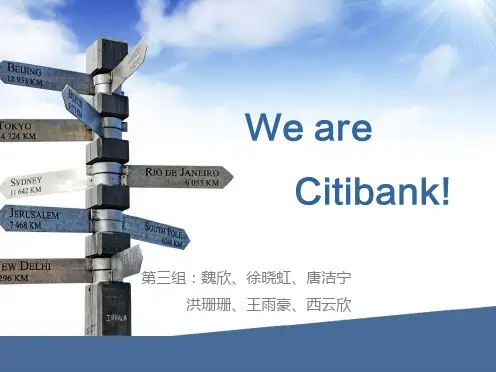
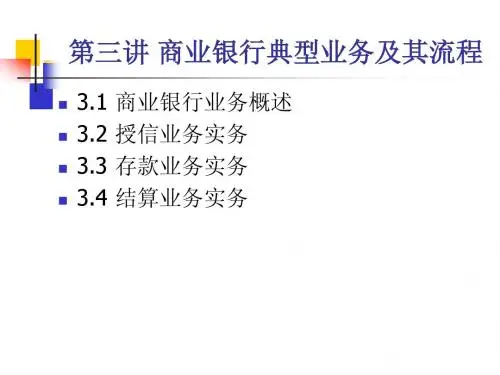

花旗集团历史在花旗的历史上,有三个重要的名字:花旗银行(Citibank)、花旗公司(Citicorp)和花旗集团(Citigroup),它代表着花旗三个不同的历史时期。
花旗银行(Citibank)花旗银行是1955年由纽约花旗银行与纽约第一国民银行合并而成的,合并后改名为纽约第一花旗银行,1962年改为第一花旗银行,1976年3月1月改为现名。
纽约花旗银行的前身是纽约城市银行(City bank of New York),1812年由斯提耳曼家族创立,经营与拉丁美洲贸易有关的金融业务。
1865年该行取得国民银行执照,改为纽约花旗银行。
19世纪末20世纪初,斯提耳曼家族和洛克菲勒家族牢牢地控制了该行,将它作为美孚石油系统的金融调度中心。
1929-1933年的世界经济危机以后,纽约花旗银行脱离了洛克菲勒财团,自成系统。
当时,由于业务每况愈下,曾一度依附于摩根公司。
到了40年代,纽约花旗银行趁第二次世界大战之机,大力恢复和扩充业务。
战后,纽约花旗银行业务不断扩展。
50年代,美国爆发了大规模的企业兼并浪潮,纽约花旗银行在竞争中壮大起来,于1955年兼并了摩根财团的第二大银行--纽约第一国民银行,随后更名为第一花旗银行,此时该行资产急剧扩大,实力增强,地位迅速上升,成为当时美国第三大银行,资产规模仅次于美洲银行和大通曼哈顿银行。
花旗公司(Citicorp)由于美国银行法对银行与证券业务实行严格的分业管理,规定商业银行不许购买股票,不允许经营非银行业务,对分支行的开设也有严格的限制。
为了规避法律的限制,1968年花旗银行走出了公司战略决策的重要一步--成立银行控股公司,以其作为花旗银行的母公司。
花旗银行把自己的股票换成其控股公司即花旗公司的股票,而花旗公司资产的99%是花旗银行的资产。
数十年来,花旗银行一直是花旗公司的“旗舰银行”,20世纪70年代花旗银行的资产一直占花旗公司资产的95%以上,80年代以后有所下降,但也在85%左右。